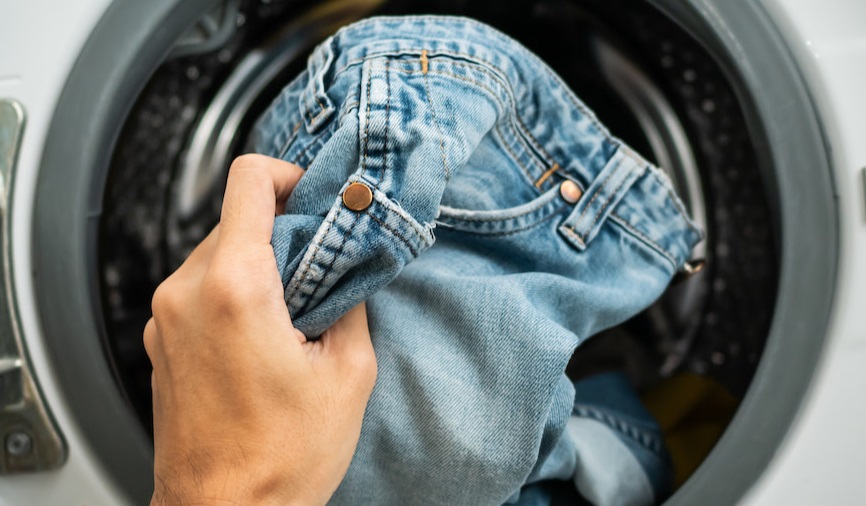You might be surprised to know that jeans that are so durable at first glance need delicate care? In order to keep attractive denim products as long as possible, you need to follow a number of simple rules, which we will talk about.
We will tell you how, with what means and with what things you can wash denim trousers.
Jeans Features
The secret of denim lies in the composition and structure of the threads. They are twisted from cotton fibers on special machines. Here are the main properties that denim is endowed with:
-
Cotton provides the fabric with breathable and hygroscopic properties. Therefore, in jeans clothes it is not hot even in the heat. Threads absorb and release moisture well.
-
A special twill weave gives the fabric volume, strength and wear resistance.
-
Twisted cotton threads are able to stretch when wet and worn and twist again at high temperatures.
-
New, often even expensive jeans, have excess dye, which turns into water when washed.
-
The natural composition of the thread makes it unstable to physical wear. The fabric becomes thinner and torn in places of constant friction.
These features affect the means and methods that we choose to care for jeans. The main features of care are the frequency of wet processing of trousers, the use of suitable modes and detergents.
We have selected the most important rules for washing and caring for jeans. After reading them, perhaps you will change the usual style of caring for jeans, thereby extending the life of your favorite things.
Why denim shouldn’t be washed often
Due to the ability of the fabric to mask small dirt, denim is not often washed. We are not talking about children’s clothes, which should always be kept clean.
You might wonder why you shouldn’t wash denim often. The fact is that with constant friction, exposure to detergents and bleaches, the following happens:
-
Cotton fibers become loose, thinner and torn.
-
Places of permanent folds wear out faster.
-
The dye gradually fades.
-
The fabric stretches and deforms in places.
Jeans should be wet cleaned after 5–6 uses. If you only wore pants once, you can safely put them back in the closet. If you wear them infrequently, then you may need to wash them every six months, or maybe less. The average frequency of washing jeans is 1 time in 4 months.
But of course you shouldn’t go to extremes. Use common sense and tidy things up as needed. If you have a stain on your trousers, do not put off washing. The sooner the contamination is removed, the better. Old stains are difficult to remove from jeans. The point is indigo dye, which quickly discolors under the influence of chemicals.
Washing alternative
If you want to freshen up your clothes or if there is a smell, you should not immediately send your jeans to the washing machine. There are 2 options for quickly restoring the appearance.
Night ventilation
Hanging out at night in fresh air will allow you to ventilate the fabric, remove odors. Nighttime humidity will even out stretchiness, and frost will give things the smell of morning freshness. This method can be applied to other clothes that need a little cheer up.
Freezing in the refrigerator compartment
This unusual method kills bacteria, restores tissue stretch, and eliminates odors. First you need to remove the stains and sprinkle the denim with vinegar from the spray bottle.
To carry out the freezing procedure, jeans are folded into a plastic bag, and then into the freezer. After freezing, they need to be taken out and hung up to weather the smell of vinegar.
Modes and suitable detergents
We recommend that you select the programs “Delicate”, “Hand” or “Quick Wash” on washing machines. They have an optimal temperature and spin mode for jeans.
Natural jeans should be washed at a temperature not exceeding 30–40 degrees and a spin speed of 400 rpm. With strong heat and excessive wringing, denim fibers shrink, and the item can significantly decrease in size.
When choosing detergents, it is worth giving preference to liquid compositions, since the particles of the washing powder clog into the fibers and make the fabric rough. If only powder is available, use half the usual dose.
Bleach should not be used to preserve the color of jeans, unless it is your deliberate decision to lighten the fabric. With frequent use of bleaching agents, in addition to color loss, the quality of the fabric itself deteriorates: the threads fluff up, become loose, thinner and torn.
Pre-preparation of things
For high-quality washing, clothes must first be prepared. First you need to remove all things and garbage from your pockets. This will prevent damage to the drum of the machine and damage to the jeans. Then follow these steps:
-
Separate things by color. You can’t wash black jeans even with blue ones. Having shed, black paint will leave dark stains on blue fabric. Accordingly, in order to avoid staining, you cannot wash white trousers with colored ones. Only if you are completely sure that things will not shed, you can put them in the wash at the same time.
-
Get rid of existing stains and dirt first. The bottom of the legs can be cleaned with a brush and laundry soap. Remove stubborn stains with special products for denim (“Vanish”, “Big Wash”, “Antipyatin”). Greasy traces are well washed with Fairy dishwashing detergent or vinegar.
-
Turn pants inside out. Fasten all buttons and zippers. This will keep the locks in working condition, protect the decor (if any) from damage, reduce fabric wear and preserve color.
Companion items for co-washing
Now, based on the previous information, you can choose the parameters of things with which jeans can be washed.
Manufacturers recommend washing denim separately from other items. Perhaps this is true for large families, where you can throw 3–4 pairs of jeans into the machine at the same time.
In other cases, we consider it appropriate to follow the following recommendations:
-
Choose items that are similar in fabric density and color for co-washing. Jeans are usually washed with cotton items. To keep blue jeans from fading, wash them with the same dark clothes. And to fix the color, add a little vinegar to the wash.
-
Feel free to take socks as companions. But in this case, choose things of the same tone. To prevent socks from getting into jeans pockets, isolate them in a special washing bag.
-
The controversial issue of simultaneous washing of underwear and outerwear can be solved as follows: if you don’t have a fad about bacteria that can be found in large quantities in jeans and migrate to underwear and cause skin diseases during washing, you can safely put things in a common drum. As practice shows, for a person who monitors his own hygiene, such unpleasant situations are excluded.
-
With jeans, you can wash textile sneakers, if you first wash the sole well from dirt. Choose the same color of things to exclude their mutual staining.
-
Avoid putting thin delicate items, knitted and lace products together with jeans in the machine. Trousers have metal elements that can damage thin fabric and pull out the loops of knitwear.
-
It is not recommended to wash bed linen with jeans only for the reason that the washing mode for bed linen is 60 degrees.
Here are examples of companion items for washing jeans:
|
|
|
|
Black
|
black and dark socks, t‑shirts, sweatshirts, tracksuits, denim
|
|
Blue
|
blue cotton and synthetic items: socks, trousers, sweatshirts, other denim clothing
|
|
light blue
|
light t‑shirts, outerwear and sportswear
|
How to wash jeans
If the issue of caring for jeans is really very important to you, we offer you an overview of special washing products designed taking into account the characteristics of denim.
-
BiMax Jeans. The tool, made in EU, has the form of a gel. It dissolves well in water. It helps to preserve and restore the color of clothes and removes stains. The average price is 3 dollars. -
Amway Home SA8 Black. American product, 1 liter at a price of 15$. Works in the temperature range from 15 to 90 degrees. Helps to hold paint, completely washed out of the fabric. Can be used for children’s clothing due to natural active ingredients. -
Lux professional. German liquid product in the form of a gel is available in a 1 liter plastic container. Economic consumption and active formula provides long and reliable care for denim. Price — 300–3,5 dollars. -
Coral Jeans. Liquid product with a volume of 1.5 liters, made in Germany. It has a pleasant aroma and pronounced care qualities, thanks to which jeans do not lose color for a long time. Active at 30 degrees. -
STORK JEANS liquid laundry detergent. The domestic brand offers an active detergent that starts working at 25 degrees, retains color and removes difficult stains. The average price is 2 dollars. -
Gel-concentrate “Big wash”. Detergent for washing jeans was released in EU. Maintains fabric quality while removing stubborn dirt. The average cost is 2 dollars. -
NORDLAND Denim Balm. German remedy, 750 ml. Operating temperature range — 20–60 degrees. Gently erases and removes impurities. Suitable for all types of washing machines. Made from natural safe ingredients. The average price is 380 rubles.
In conclusion, we note that jeans are not uniforms that require strict wearing. This is a thing that you create yourself. Over time, it only improves, acquiring a comfortable fit and individual features. It would be a pity to lose a favorite thing. Therefore, when caring for jeans, follow some simple rules and follow some precautions to avoid premature damage.



Добавить комментарий
Для отправки комментария вам необходимо авторизоваться.